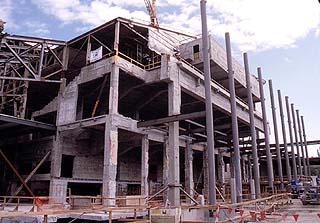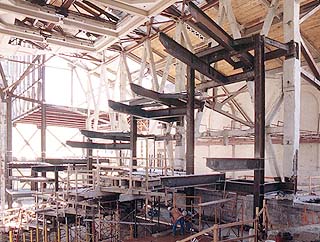|
Subscribe / Renew |
|
|
Contact Us |
|
| ► Subscribe to our Free Weekly Newsletter | |
| home | Welcome, sign in or click here to subscribe. | login |
Architecture & Engineering
| |
 |
June 5, 2003
Bracing for a new future
Magnusson Klemencic Associates

Photo by Michael Dickter, MKA
Steel support beams attach to the lobby’s concrete-filled steel columns to create a structural support system for the 65-foot-high glass wall. |
The redevelopment of the Seattle Opera House is an example of how — given modern, efficient upgrade solutions — an existing structure with weaknesses can be reborn to provide enjoyment for generations to come.
The renovation keeps the original 1927 Civic Auditorium (and later the Opera House auditorium) structure and uses it as the link that connects many newly expanded areas that encircle the original auditorium space. It is in these new areas many of the building’s new amenities exist.
Seismic assessment
The evolution of this building’s redevelopment started nearly 10 years ago.
In 1994, the Seattle Center commissioned a seismic assessment of the Opera House/Mercer Arena complex. The assessment was to determine the anticipated performance of the building during earthquakes of different magnitudes and to provide upgrade recommendations for structural elements that did not exhibit an acceptable seismic response.
The assessment found that significant seismic upgrades would be needed to meet “life safety” performance in the event of an earthquake. The recommendations were to add seismic elements such as concrete shear walls throughout the building.
The Seattle Center agreed with the need for the seismic upgrades and started assessing the impact to the building. The study found the cost to remove and replace the building’s interior elements would be at least as expensive as the seismic upgrade.
The study, however, considered only the building’s existing configuration and level of finish. It was only after the Seattle Opera and Pacific Northwest Ballet came forward to propose a public-private partnership that plans for the project grew beyond their seismic component.
New building configuration
After the newly expanded building program had been developed, many new program features and load requirements were established.
It was decided to demolish the front third of the existing building and replace it with an exterior promenade and a grand multi-story lobby. Large multi-story expansions were added to the north and south side of the auditorium where new donor rooms and expanded restrooms are located.
In order to meet state-of-the-art production capacity and standards, the stage framing was replaced, doubling the loading capacity of the system. This was accomplished while still maintaining a floor-to-floor height of 9 feet 8 inches to the orchestra level below.
The fly loft above the stage and its rigging gridiron were raised 25 feet to provide over 100 feet of usable height and volume needed for contemporary scenery space requirements.
South of the new stage, a scenery-handling area provides a clearance height up to 40 feet. A new loading dock and elevated access ramp behind the Mercer Arena, adjacent to the scenery handling area, was also added.
Seismic upgrade
Even with the new building program, the most important structural requirement was to seismically upgrade the structure. Before the seismic system could be defined, an understanding of the future building configuration and its interface with the remaining existing building had to be established. To appreciate the needs for the old and new construction interface, research into the earlier construction had to be done.
Review of the original 1927 building documents helped to define the basic building structure. Also, documents from a major renovation in 1960 show how the renovation not only added many new elements to consider, but that many portions of the original structure had been entombed behind the newer brick exterior walls. The hidden portions became added challenges that had to be understood and dealt with as the new renovation began.

Photo by Michael Dickter, MKA
Changes to the auditorium included new side boxes and balcony extensions. The cantilevered framing, shown here, supports the side boxes. |
After it was determined which portions of the original building were to remain, lateral elements had to be located so that the older construction elements would exhibit acceptable performance in a seismic event.
Because the expansion basically encircles the original structure, it was determined that an entirely new lateral bracing system would be designed for the building.
Most new elements were located in the new construction areas and linked elements to the older construction were incorporated to tie them together. Special care was given to make sure the design assumptions and load paths of the earlier constructions were not compromised in the design of the new system.
It was also found that not only had there been one major renovation to the building, but a number of specific upgrade renovations had been made since 1960. In some cases, these other upgrades required up to five sets of drawings from different construction periods to be used to coordinate certain parts of the building during the new design.
Lobby and auditorium
In the lobby, a 65-foot-tall serpentine glass wall defines the new front of the building. Because of the wall system chosen, an intermediate structural framing system was needed to laterally brace the wall for wind and seismic forces.
An girt system was incorporated behind the wall system to provide the needed support. The girt system was then attached to the lobby’s concrete-filled steel columns to complete a lateral-restraining support system for the glass wall.
The use of the hanging rod, narrow channels and incorporation of the building columns provided a backup structure that does not interfere with the openness of the glass-walled lobby.

McCaw Hall incorporates numerous elements from its previous incarnations, including the original 1927 Civic Auditorium structure and additions from the 1962 Seattle Opera House.
|
Outside the serpentine wall, scrims were added to provide a surface to project artistic light imagery. These metal screens are supported by tensioned cables above and below the elements that span across the new promenade.
The cables have been tuned to a tension that will prevent the scrims from moving more than 18 inches in a severe wind storm. The restriction prevents the images on the scrims from becoming distorted.
Inside the auditorium the seating configuration was significantly changed. New side boxes and balcony extensions were added to enhance the best seating views.
Cantilevered steel framing was incorporated to provide the new amenities, yet still remained shallow enough to steer clear of sight lines in the lower seating areas. Also, a new sloping floor system was added to improve sight lines and seismic reliability in the seating area.
Ken Dahl is a senior associate with Magnusson Klemencic Associates.
Other Stories:
- Demolition crews keep danger at bay
- At McCaw Hall, the performance begins outside
- A breath of fresh air
- A centerpiece for Seattle Center


